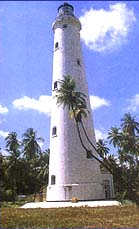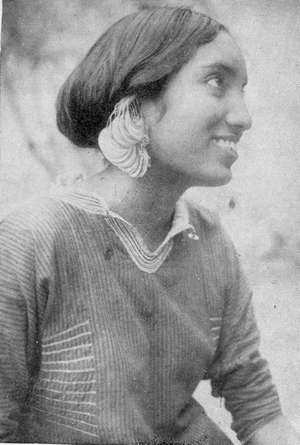 |
 |
| "A Hero in Time"? Divehi-ganduvaru (Maldive Palace) was reputedly the residence of a 16th century rebel leader from the Maldives by the name of Mohamed Thakurufan, kateeb of Uteem Island to the south of Minicoy. Thakurufan and his associates took up arms against their king (Hassan IX later known as Manoel) who had converted to Christianity. They made Minicoy their base while making raids on islands under the sovereign control of their king. Thakurufan was an agent of the Ali Raja of Cannanore under whose rule Minicoy was at that time.The nature of the relationship between Mohamed Thakurufan and the Ali Raja of Cannanore was outlined in a letter sent by a later Ali Raja, Mariyambe Ali Adi Raja Bibi, to the Sultan Mohamed Mueenuddine I of the Maldives. The letter was dated Friday 17 Jamada-el-oula Anno Hegirae 1243 (7 December AD 1827). According to the letter Mohamed Thakurufan had entered into a treaty ceding sovereignty of the Maldives to the Ali Raja of Cannanore in the event Thakurufan was established in power in Male. (refer page 294 of Divehi Tarikh). A reply was sent from Malè explaining that Thakurufan had no legal authority to enter into such a treaty with the Ali Raja of Cannanore. (see also Myth of Portuguese Rule) |
| Thaana
Fonts |
| Download and install to create your Mahl texts Windows
fonts |
| Newspapers
of Minicoy interest |
||||||||||||||||||||||||||||||||||||
|
||||||||||||||||||||||||||||||||||||
"Not many know that nine years after India's Independence, the Union Jack was found fluttering on a lighthouse at Minicoy in Lakshwadeep. The wizened lighthouse keeper was unaware that India had become independent. When the inadvertent lapse was discovered in April 1956, the British government sent a special officer to lower the Union Jack." CHETAN KRISHNASWAMY, TIMES NEWS NETWORK, OCTOBER 25, 2001 An insult to a Minicoy lighthouse keeper's intelligence or were things that simplistic back then? Minicoy islanders had long been well-informed globe-trotters. Ed. |
Location Minicoy, locally known as Maliku, is the southern most island in the Indian Union Territory of Lakshadweep, formerly known as the Laccadive, Minicoy and Amindivi Islands. Minicoy is further most from the territorial capital of Kavaratti island, which is 200 km away to the north of Minicoy. The closest land to Minicoy is Thuraakunu Island in the Republic of the Maldives about 100 km to the south across the Vangaaru Channel. Culture Minicoy has a culture very different from any other island in the Union Territory. Dress, language, customs, arts and food are identical to the non-Indian islands to the south. Minicoy has a cluster of 10 villages, which are called avarh, each presided over by a Bodukaaka. Language The main language spoken in Lakshadweep is
officially considered a dialect of Malayalam but sounds more like
Tamil. Both Tamil and Malayalam are Dravidian languages spoken in
the southern parts of mainland India.
The Lakhshadweep Administration refers to Divehi-bas as Mahl. This is due to a misunderstanding on the part of a British civil servant who came to Minicoy in the Twentieth Century during the time of the Indian Empire. The official asked a local what his language was and he said "Divehi-bas". The Englishman looked confused as he had never heard of this language. Noticing this, the islander said "Mahaldeebu" as he knew that people on the subcontinent referred to the kingdom to the south (the Maldives) by that name. The local name was and is Divehiraajje (Kingdom of Islands) and the language is Divehi-bas (language of the islands). The English official recorded the language of Minicoy as Mahl. Why Minicoy? Minicoy is locally known as Maliku, which is
the name of the island in the Maldive-Minicoy language. So how did
this transform into Minicoy? People Within the status group system of Minicoy, the Bodun or Manikfans are considered to be of the highest class. They alone owned private property and were the leisured class. The Malimin or Thakurufans were the sailors who mainly piloted sailing vessels.
Medukembin or Takurus worked in the boats during voyages while the Raveris were the labourers. Women of the four status groups are known as Manikka, Beefan, Beebee and Kambilo respectively. In between Thakurufan and Thakuru , there is a sub-caste known as Bebe. According to local oral tradition, the four status groups correspond to those among the passengers and crew of a ship carrying two Maldive princesses Kamboranin and Kohoratukamana that came to Minicoy sometime in antiquity. Those who sailed in the ship displaced the previous inhabitants of the island and became the ancestors of modern Minicoy islanders. Marco Polo referred to Minicoy as the "female island" because of its matrilineal society. Until recently real estate was retained by women and passed in the female line. Both men and women took on their mothers' surnames (house names). Upon marriage, the husband took the wife's surname. All affairs of the household were managed by the senior female member.
|
|
|
|
|



 rss feed
rss feed 





